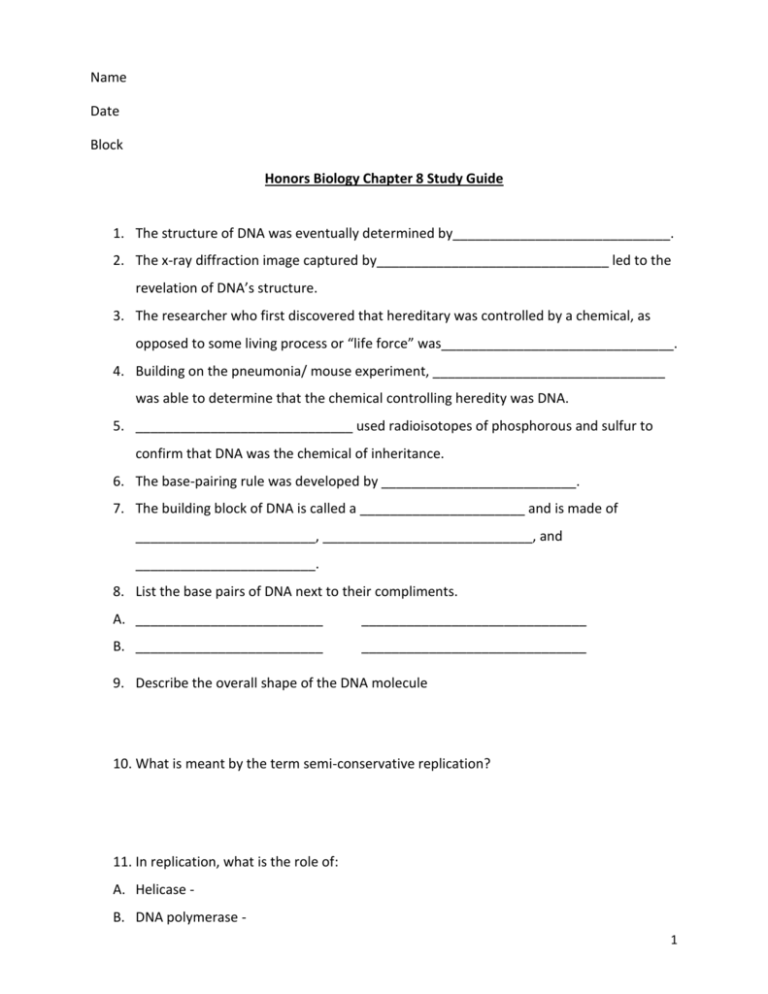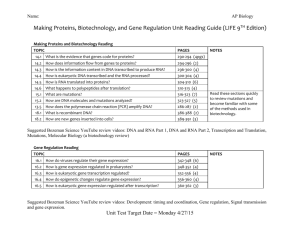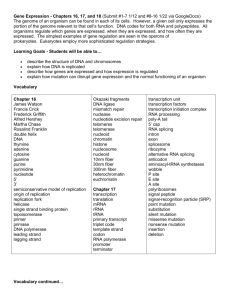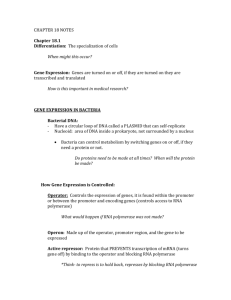hnrs bio chp 8 study guide
advertisement

Name Date Block Honors Biology Chapter 8 Study Guide 1. The structure of DNA was eventually determined by_____________________________. 2. The x-ray diffraction image captured by_______________________________ led to the revelation of DNA’s structure. 3. The researcher who first discovered that hereditary was controlled by a chemical, as opposed to some living process or “life force” was_______________________________. 4. Building on the pneumonia/ mouse experiment, _______________________________ was able to determine that the chemical controlling heredity was DNA. 5. _____________________________ used radioisotopes of phosphorous and sulfur to confirm that DNA was the chemical of inheritance. 6. The base-pairing rule was developed by __________________________. 7. The building block of DNA is called a ______________________ and is made of ________________________, ____________________________, and ________________________. 8. List the base pairs of DNA next to their compliments. A. _________________________ ______________________________ B. _________________________ ______________________________ 9. Describe the overall shape of the DNA molecule 10. What is meant by the term semi-conservative replication? 11. In replication, what is the role of: A. Helicase B. DNA polymerase 1 12. Contrast DNA and RNA using the table below. DNA RNA Base pairs present Number of strands Sugar General Function 13. Outline a description of the steps of protein synthesis. You should have three roman numerals as a framework: I. Transcription II. RNA processing and III. Translation. (Be sure to include all necessary terms, including, but not limited to, RNA polymerase, introns, exons, end caps, tail, mRNA, rRNA, tRNA, stop and start codons, amino acids, peptide bonds, polypeptide. 2 14. Describe the role of the following in prokaryotic gene regulation and transcription A. Structural geneB. Promotor C. Operator D. Regulatory or repressor gene E. Repressor F. Activator G. RNA polymerase 15. Sketch a prokaryotic chromosome and label the structures listed in question 15. 16. Contrast inducible and repressible transcription mechanisms. 17. Considering the terms in question # 17, to which groups does the Lac operon belong (A)…the Tryp operon (B)? A. B. 18. Describe the role of the following in eukaryotic gene regulation and transcription. A. Structural gene B. Promotor C. TATA box D. Enhancer E. Silencer F. General transcription factors G. RNA polymerase H. Activator 3 I. Signal molecule J. Repressor 19. Sketch a chromosome and label the structures listed in question 19. 20. When (during protein synthesis) does prokaryotic gene regulation occur? 21. When (during protein synthesis) does MOST eukaryotic gene regulation usually occur? 22. When (during protein synthesis) can gene regulation also occur in eukaryotic cells? A. B. C. D. E. 23. In a clear and complete sentence, state Watson’s central dogma. 4 24. Shown below (for diagrammatic purposes) is a chromatid from 2 pairs of homologous chromosomes during prophase I. Below each type of chromosomal mutation (A-D), sketch & label what a chromatid from these pairs might look like if that type of chromosomal mutation were to occur. A. Deletion B. Duplication C. Inversion D. Translocation 26. What is nondisjunction? 27. During what stage in the cell cycle does nondisjunction occur? 28. What effect might nondisjunction have? 29. What would be the mRNA transcript of the DNA sequence below. TACGGGATACCAGCGATC 5 30. Translate the transcript that you derived in the previous question. 31. Gene mutations arise from two sources…what are they? A. B. 32. What is a mutagen? 33. How does a gene mutation differ from a chromosome mutation? 34. What is a point mutation? 35. Describe the following type of gene mutations. A. Deletion B. Insertion C. Substitution 36. What type(s) of point mutations cause a frame shift mutation? Why? 37. What happens to the nucleosomes when epigenetic controls cause a gene to NOT be expressed? 38. What is a Hox gene? 6 7










